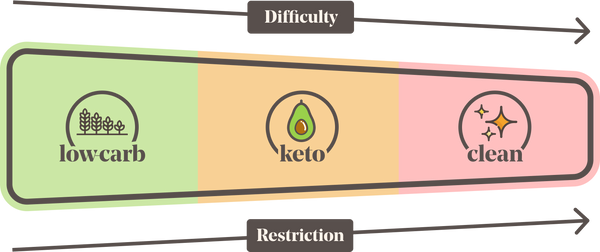At Low Carb Food Co, we classify our products into three main categories: Low Carb, Keto and Clean, based on strict carbohydrate content and ingredient quality criteria.
As you would expect from the name, all our products are low-carb, in that they're generally less than 10% carbohydrate content.
There are some exceptions, such as where a single portion of the products is less than 100g and is itself a full meal.
An example would be breakfast granola, which is 15% carbs, but a 40g portion only contains 6g of carbs, which we consider acceptable for a single meal.
However, not all low-carb products are created equal, and carbohydrate content isn't the only consideration.
If you give it a quick search online, you’ll find a quagmire of varying definitions of what does and doesn’t qualify as “Low Carb” or “Keto”; there is no single scientific definition. It makes it quite difficult to conform to everyone’s idea of what qualifies, and so you’ll often find a lot of debating (sometimes polite, sometimes not so polite!) in the comments sections of our website and social media.
So, to clear things up, we’ll show you how we internally classify all our products as suitable for either Low Carb, Keto and Clean.
❗Remember, our classification is just a guide. Not everyone follows the same rules, and we respect that. Listen to your healthcare professional, your body, and adjust as necessary!
Our Low-Carb Scale
You can think of these classifications on a scale of difficulty level, with Low Carb being the easiets, and Clean Keto being the most difficult. As you go from one end of the scale to the other, the diet becomes more restrictive and therefore more challenging.

(It’s worth noting that some people find heavier restrictions easier to stick to as there’s less of a grey area for them — everyone’s different!)
When it comes to classifying our products, we’re looking at two things:
✅ carbohydrates per 100g; and
✅ ingredients.
Carbohydrates per 100g
Generally speaking, the fewer the carbs, the more effective the diet appears to be for weight loss and for treating type 2 diabetes 1,2.
However, eating fewer carbs can also make the diet more restrictive and can make it feel more challenging to sustain.
Ingredients
We don’t just look at the level of carbohydrates to classify our food; we also look carefully for certain ingredients.
When it comes to looking at a product’s ingredients list, we’re mainly concerned with sweeteners, grains and processed vegetable oils. We’re about keeping things clean and simple, just the way nature intended. It’s why you’ll also rarely find any artificial preservatives or additives in our low-carb foods.
For example, our low-carb bread is classified as low carb and keto, but not clean keto. Yes, our low-carb bread is incredibly low in carbs, but it contains vital wheat gluten (that helps the bread to rise) and oat fibre (which adds flavour). Neither ingredient adds to the carb count (they’re protein and fibre), but grain derivatives are unacceptable to most people following a clean keto diet.
Definitions
Here are the definitions we use to source and classify all the products we stock at Low Carb Food Co:
| Nutrition | Low Carb | Keto | Clean |
| Carbohydrates per 100g | 10g | 7g | 5g |
|
Ingredients |
Low Carb | Keto | Clean | |
| Sweeteners | Inulin | ✅ | ✅ | ✅ |
| Stevia, Erythritol, Oligosaccharides | ✅ | ✅ | ❌ | |
| Grains | Wheat, barley, oats, rice | ❌ | ❌ | ❌ |
| Derivatives (vital wheat gluten, oat fibre, soya) | ✅ | ✅ | ❌ | |
| Oils | Fruit oils (olive oil, coconut oil, avocado oil) | ✅ | ✅ | ✅ |
| Seed oils (e.g. rapeseed oil) | ✅ | ❌ | ❌ | |
| Processed vegetable oils | ❌ | ❌ | ❌ |
Don't agree?
We understand that you might not agree with our definitions, but we encourage you to use them as a guide. If you’ve got your own definitions, we make sure that we provide all the information on nutrition and ingredients that you need to make your own decisions!
As Diet Doctor rightly says:
How few carbs are there in a low-carb diet? It depends on who you are, what you find sustainable, and what you’re trying to achieve.
However, if you have suggestions on how we could adjust or improve our definitions for the benefit of our mission to make it easier to follow a low-carb lifestyle, be sure to let us know. We’re always listening!




